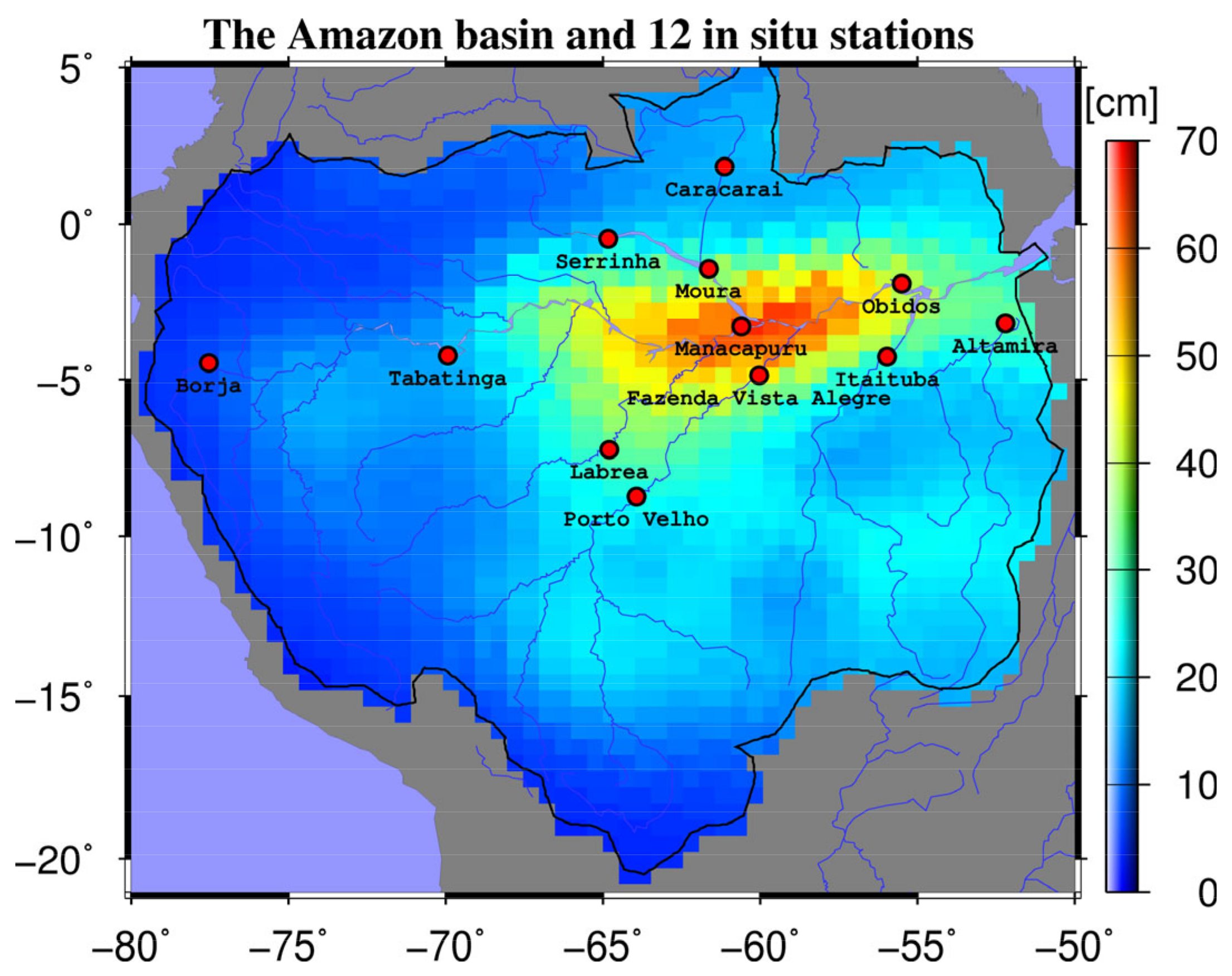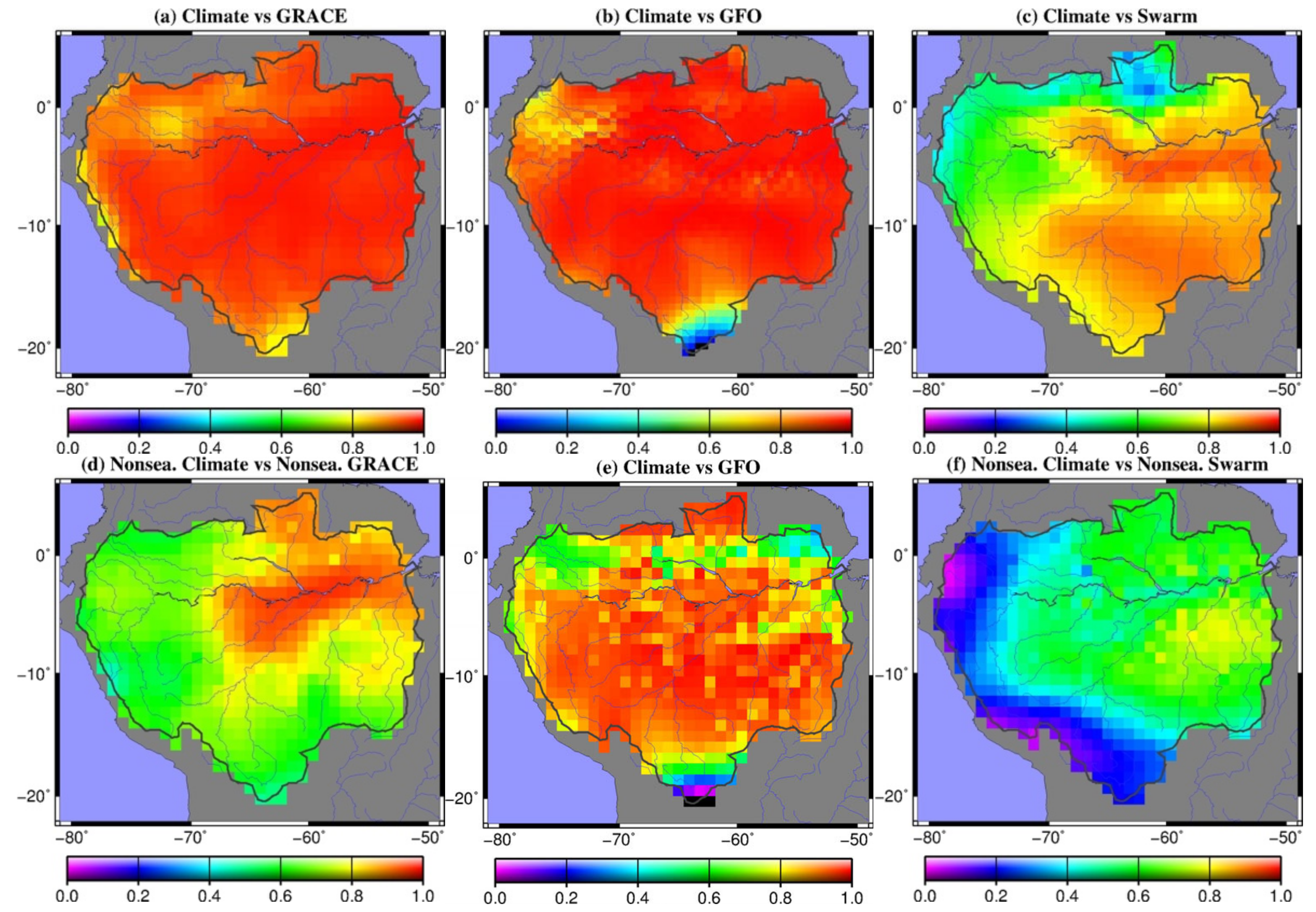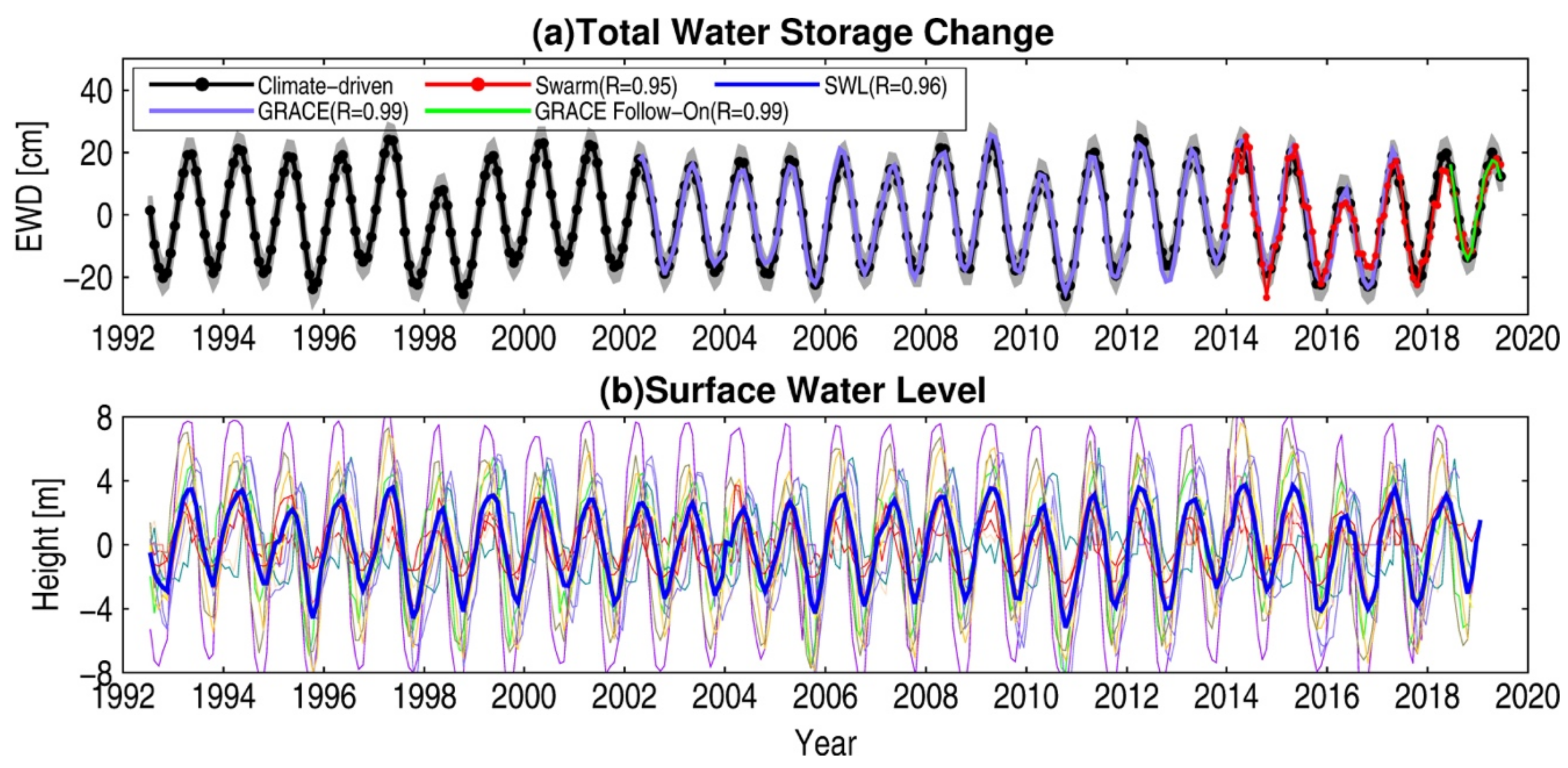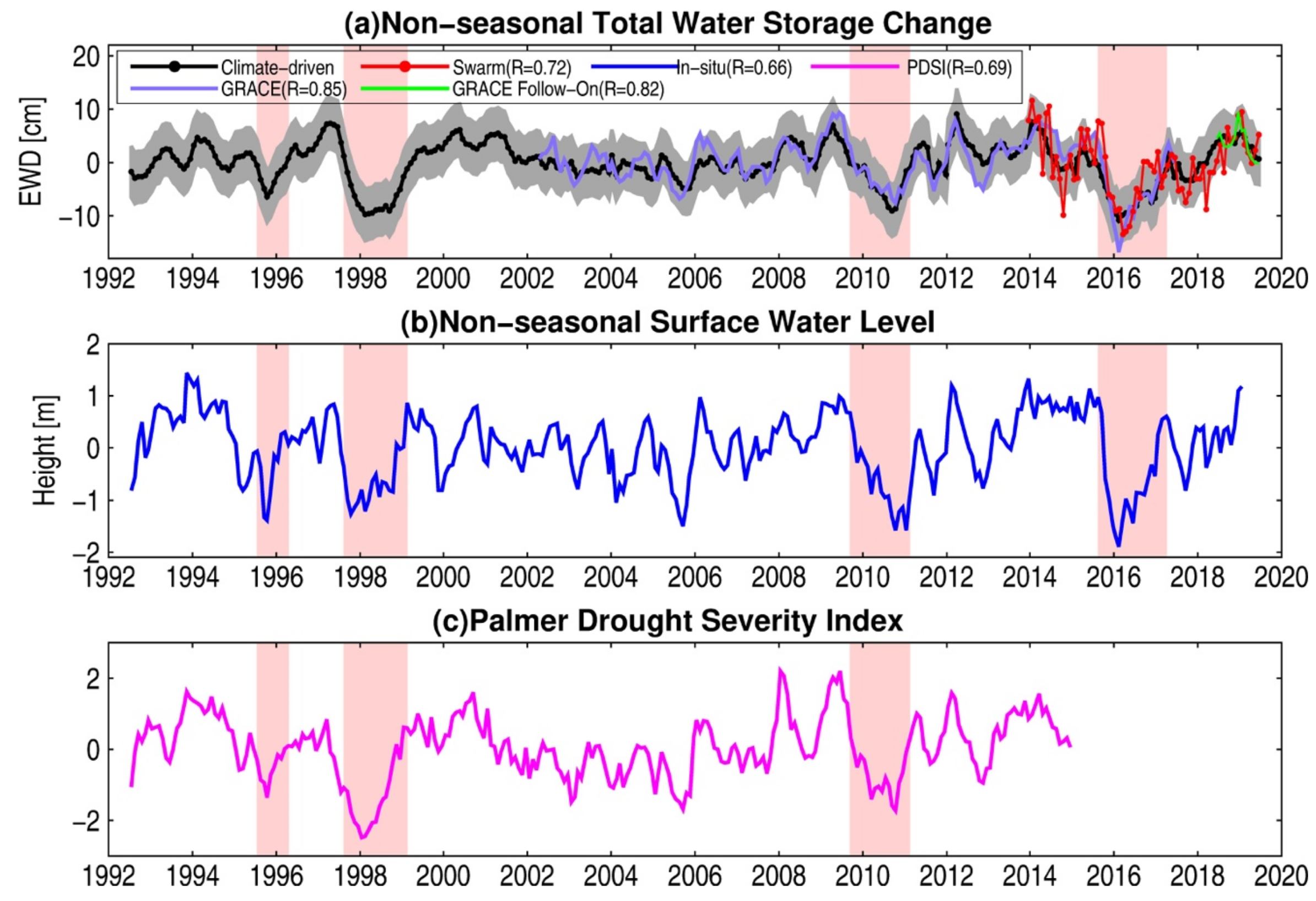Drought Events over the Amazon River Basin (1993–2019) as Detected by the Climate-Driven Total Water Storage Change
Abstract
:1. Introduction
2. Materials and Methods
2.1. Materials
2.1.1. Total Water Storage Change Fields
2.1.2. Climate Input Data
2.1.3. In Situ Observations
2.1.4. Palmer Drought Severity Index
2.1.5. Data Analysis
2.2. Methods
2.2.1. Estimation of the Total Water Storage Changes Using GRACE-FO Gravity Field Models
2.2.2. Prediction of the Total Water Storage Changes
Principal Component Analysis (PCA)
Least Square (LS) Fitting
Multiple Linear Regression (MLR)
Signal Compositions
3. Results
3.1. Uncertainty Estimates of the Model Outputs
3.2. Climate-Driven Total Water Storage Change Fields
3.3. Drought Events Identified from the Basin-Averaged Climate-Driven Total Water Storage Change
3.4. Drought Patterns Interpreted from the Climate-Driven Total Water Storage Change Fields
4. Discussions
5. Conclusions
Author Contributions
Funding
Data Availability Statement
Acknowledgments
Conflicts of Interest
Appendix A





References
- Ahmadi, B.; Ahmadalipour, A.; Moradkhani, H. Hydrological drought persistence and recovery over the CONUS: A mul-ti-stage framework considering water quantity and quality. Water Res. 2019, 150, 97–110. [Google Scholar] [CrossRef]
- Yu, Z.; Wang, J.; Liu, S.; Rentch, J.S.; Sun, P.; Lu, C. Global gross primary productivity and water use efficiency changes under drought stress. Environ. Res. Lett. 2017, 12, 014016. [Google Scholar] [CrossRef] [Green Version]
- Zhang, D.; Liu, X.; Bai, P. Assessment of hydrological drought and its recovery time for eight T tributaries of the Yangtze River (China) based on downscaled GRACE data. J. Hydrol. 2019, 568, 592–603. [Google Scholar] [CrossRef]
- Zalewski, M.; McClain, M.; Eslamian, S. New challenges and dimensions of Ecohydrology—Enhancement of catchments sustainability potential. Ecohydrol. Hydrobiol. 2016, 16, 1–3. [Google Scholar] [CrossRef]
- Jassey, V.E.J.; Reczuga, M.K.; Zielińska, M.; Sowińska, S.; Robroek, B.J.M.; Mariotte, P.; Seppey, C.; Lara, E.; Barabach, J.; Słowiński, M.; et al. Tipping point effect in plant-fungal interactions under severe drought causes abrupt rise in peatland ecosystem respiration. Global Change Biol. 2017, 24, 972–986. [Google Scholar] [CrossRef]
- Peng, B.; Xiaomang, L.; Yongqiang, Z.; Changming, L. Incorporating vegetation dynamics noticeably improved performance of hydrological model under vegetation greening. Sci. Total Environ. 2018, 643, 610–622. [Google Scholar]
- Tapley, B.D.; Bettadpur, S.; Watkins, M.; Reigber, C. The gravity recovery and climate experiment: Mission overview and early results. Geophys. Res. Lett. 2004, 31, 09607. [Google Scholar] [CrossRef] [Green Version]
- Swenson, S.C.; Wahr, J.M. Methods for inferring regional surface-mass anomalies from Gravity Recovery and Climate Experiment (GRACE) measurements of time-variable gravity. J. Geophys. Res. Space Phys. 2002, 107, ETG3. [Google Scholar] [CrossRef] [Green Version]
- Andersen, O.B.; Seneviratne, S.I.; Hinderer, J.; Viterbo, P. GRACE-derived terrestrial water storage depletion associated with the 2003 European heat wave. Geophys. Res. Lett. 2005, 32. [Google Scholar] [CrossRef]
- Frappart, F.; Ramillien, G. Monitoring Groundwater Storage Changes Using the Gravity Recovery and Climate Experiment (GRACE) Satellite Mission: A Review. Remote Sens. 2018, 10, 829. [Google Scholar] [CrossRef] [Green Version]
- Thomas, A.C.; Reager, J.T.; Famiglietti, J.S.; Rodell, M. A GRACE-based water storage deficit approach for hydrological drought characterization. Geophys. Res. Lett. 2014, 41, 1537–1545. [Google Scholar] [CrossRef] [Green Version]
- Chao, N.; Wang, Z.; Jiang, W.; Chao, D. A quantitative approach for hydrological drought characterization in southwestern China using GRACE. Hydrogeol. J. 2016, 24, 893–903. [Google Scholar] [CrossRef]
- Hall, A.C.; Schumann, G.J.-P.; Bamber, J.L.; Bates, P.D. Tracking water level changes of the Amazon Basin with space-borne remote sensing and integration with large scale hydrodynamic modelling: A review. Phys. Chem. Earth 2011, 36, 223–231. [Google Scholar] [CrossRef]
- Ning, N.; Wanchang, Z.; Huadong, G.; Natarajan, I. 2010–2012 drought and flood events in the amazon basin inferred by grace satellite observations. J. Appl. Remote Sens. 2015, 9, 096023. [Google Scholar]
- Clark, E.A.; Sheffield, J.; Van Vliet, M.T.H.; Nijssen, B.; Lettenmaier, D.P. Continental Runoff into the Oceans (1950–2008). J. Hydrometeorol. 2015, 16, 1502–1520. [Google Scholar] [CrossRef]
- Nepstad, D.C.; Stickler, C.M.; Filho, B.S.; Merry, F. Interactions among Amazon land use, forests and climate: Prospects for a near-term forest tipping point. Philos. Trans. R. Soc. B Biol. Sci. 2008, 363, 1737–1746. [Google Scholar] [CrossRef] [Green Version]
- Vergopolan, N.; Fisher, J.B. The impact of deforestation on the hydrological cycle in Amazonia as observed from remote sensing. Int. J. Remote Sens. 2016, 37, 5412–5430. [Google Scholar] [CrossRef]
- Field, C.B.; Behrenfeld, M.J.; Randerson, J.T.; Falkowski, P. Primary Production of the Biosphere: Integrating Ter- restrial and Oceanic Components. Science 1998, 281, 237–240. [Google Scholar] [CrossRef] [Green Version]
- Malhi, Y.; Roberts, J.T.; Betts, R.A.; Killeen, T.J.; Li, W.; Nobre, C.A. Climate Change, Deforestation, and the Fate of the Amazon. Science 2008, 319, 169–172. [Google Scholar] [CrossRef] [Green Version]
- Cox, P.M.; Betts, R.A.; Collins, M.; Harris, P.P.; Huntingford, C.; Jones, C.D. Amazonian forest dieback under climate-carbon cycle projections for the 21st century. Theor. Appl. Clim. 2004, 78, 137–156. [Google Scholar] [CrossRef]
- Nobre, C.A.; Sellers, P.J.; Shukla, J. Amazonian Deforestation and Regional Climate Change. J. Clim. 1991, 4, 957–988. [Google Scholar] [CrossRef] [Green Version]
- Suyog, C.; Yadu, P.; Emilio, M.; Gonzalo, M. Multi-decadal hydrologic change and variability in the Amazon River basin: Understanding terrestrial water storage variations and drought characteristics. Hydrol. Earth Syst. Sci. 2019, 23, 2841–2862. [Google Scholar]
- Paredes-Trejo, F.; Barbosa, H.A.; Giovannettone, J.; Kumar, T.V.L.; Thakur, M.K.; Buriti, C.D.O. Long-Term Spatiotemporal Variation of Droughts in the Amazon River Basin. Water 2021, 13, 351. [Google Scholar] [CrossRef]
- Xavier, L.; Becker, M.; Cazenave, A.; Longuevergne, L.; Llovel, W.; Filho, O.C.R. Interannual variability in water storage over 2003–2008 in the Amazon Basin from GRACE space gravimetry, in situ river level and precipitation data. Remote Sens. Environ. 2010, 114, 1629–1637. [Google Scholar] [CrossRef] [Green Version]
- Chen, J.L.; Wilson, C.R.; Tapley, B.D. The 2009 exceptional Amazon flood and interannual terrestrial water storage change observed by GRACE. Water Resour. Res. 2010, 46. [Google Scholar] [CrossRef] [Green Version]
- Feng, W.; Lemoine, J.M.; Zhong, M.; Xu, H. Monitoring Land Water Change in The Amazon Basin from 2002 to 2010 Using GRACE. Chin. J. Geophys. 2012, 55, 814–821. [Google Scholar]
- Jin, Z.; Jin, T. Combined GRACE and Meteorological and Hydrological Data to Study the Relationship between the Abnormal Change of Water Storage and Extreme Climate ENSO in The Amazon from 2010 to 2016. Geod. Geodyn. 2019, 39, 199–203. [Google Scholar]
- A Marengo, J.; Espinoza, J.C. Extreme seasonal droughts and floods in Amazonia: Causes, trends and impacts. Int. J. Clim. 2016, 36, 1033–1050. [Google Scholar] [CrossRef]
- Da Encarnação, J.T.; Visser, P.; Arnold, D.; Bezdek, A.; Doornbos, E.; Ellmer, M.; Guo, J.; Ijssel, J.V.D.; Iorfida, E.; Jäggi, A.; et al. Description of the multi-approach gravity field models from Swarm GPS data. Earth Syst. Sci. Data 2020, 12, 1385–1417. [Google Scholar] [CrossRef]
- Save, H.; Bettadpur, S.; Tapley, B.D. High-resolution CSR GRACE RL05 mascons. J. Geophys. Res. Solid Earth 2016, 121, 7547–7569. [Google Scholar] [CrossRef]
- Lück, C.; Kusche, J.; Rietbroek, R.; Löcher, A. Time-variable gravity fields and ocean mass change from 37 months of kinematic Swarm orbits. Solid Earth 2018, 9, 323–339. [Google Scholar] [CrossRef] [Green Version]
- Humphrey, V.; Gudmundsson, L.; Seneviratne, S.I. A global reconstruction of climate-driven subdecadal water storage variability. Geophys. Res. Lett. 2017, 44, 2300–2309. [Google Scholar] [CrossRef]
- Li, F.; Kusche, J.; Rietbroek, R.; Wang, Z.; Forootan, E.; Schulze, K.; Lück, C. Comparison of Data-Driven Techniques to Reconstruct (1992–2002) and Predict (2017–2018) GRACE-Like Gridded Total Water Storage Changes Using Climate Inputs. Water Resour. Res. 2020, 56, 026551. [Google Scholar] [CrossRef] [Green Version]
- Chen, M.; Shi, W.; Xie, P.; Silva, V.B.S.; Kousky, V.E.; Higgins, R.W.; Janowiak, J.E. Assessing objective techniques for gauge-based analyses of global daily precipitation. J. Geophys. Res. Space Phys. 2008, 113, 113. [Google Scholar] [CrossRef]
- Chen, J.L.; Wilson, C.R.; Tapley, B.D.; Yang, Z.L.; Niu, G.Y. 2005 drought event in the Amazon River basin as measured by GRACE and estimated by climate models. J. Geophys. Res. Space Phys. 2009, 114, 05404. [Google Scholar] [CrossRef]
- Fan, Y.; Dool, H.V.D. Climate prediction center global monthly soil moisture data set at 0.5° resolution for 1948 to present. J. Geophys. Res. 2004, 109, D10102. [Google Scholar] [CrossRef] [Green Version]
- Reynolds, R.W.; Rayner, N.A.; Smith, T.M.; Stokes, D.C.; Wang, W. An improved in situ and satellite SST analysis for climate. J. Clim. 2002, 15, 1609–1625. [Google Scholar] [CrossRef]
- Dai, A. Characteristics and trends in various forms of the Palmer Drought Severity Index during 1900. J. Geophys. Res. Space Phys. 2011, 116. [Google Scholar] [CrossRef] [Green Version]
- Cheng, M.; Ries, J.C.; Tapley, B.D. Variations of the Earth’s figure axis from satellite laser ranging and GRACE. J. Geophys. Res. Solid Earth 2011, 116. [Google Scholar] [CrossRef] [Green Version]
- Peltier, W. Global Glacial Isostasy and the Surface of the Ice-Age Earth: The ICE-5G (VM2) Model and GRACE. Annu. Rev. Earth Planet. Sci. 2004, 32, 111–149. [Google Scholar] [CrossRef]
- Swenson, S.C.; Wahr, J.M.; Milly, P.C.D. Estimated accuracies of regional water storage variations inferred from the Gravity Recovery and Climate Experiment (GRACE). Water Resour. Res. 2003, 39, 375–384. [Google Scholar] [CrossRef]
- Wahr, J.; Molenaar, M.; Bryan, F. Time variability of the earth’s gravity field: Hydrological and oceanic effects and their possible detection using grace. J. Geophys. Res. Solid Earth 1998, 103, 30205–30230. [Google Scholar] [CrossRef]
- Forootan, E.; Kusche, J.; Loth, I.; Schuh, W.-D.; Eicker, A.; Awange, J.; Longuevergne, L.; Diekkrueger, B.; Schmidt, M.; Shum, C.K. Multivariate prediction of total water storage anomalies over West Africa from multi-satellite data. Surv. Geophys. 2014, 35, 913–940. [Google Scholar] [CrossRef] [Green Version]
- Church, J.A.; White, N.J.; Coleman, R.; Lambeck, K.; Mitrovica, J.X. Estimates of the regional distribution of sea level rise over the 1950–2000 period. J. Clim. 2004, 17, 2609–2625. [Google Scholar] [CrossRef]
- Becker, M.; Meyssignac, B.; Xavier, L.; Cazenave, A.; Alkama, R.; Decharme, B. Past terrestrial water storage (1980–2008) in the Amazon Basin reconstructed from GRACE and in situ river gauging data. Hydrol. Earth Syst. Sci. 2011, 15, 533–546. [Google Scholar] [CrossRef] [Green Version]
- Haario, H.; Laine, M.; Mira, A.; Saksman, E. DRAM: Efficient adaptive MCMC. Stat. Comput. 2006, 16, 339–354. [Google Scholar] [CrossRef]








| PDSI | Wet and Dry Grades | PDSI | Wet and Dry Grades |
|---|---|---|---|
| ≥4 | Extremely wet | [−1,1) | normal |
| [3,4) | Severe wet | [−2,−1) | Slight drought |
| [2,3) | Moderately wet | [−3,−2) | Moderate drought |
| [1,2) | Slightly wet | (−4,−3) | Severe drought |
| ≤−4 | Extreme drought |
| Classification | Data | Resolution | Period | Source or Reference |
|---|---|---|---|---|
| Total Water Storage Change | GRACE | 0.5° × 0.5° | From April 2002 to June 2017 | CSR |
| Swarm | 0.5° × 0.5° | From December 2013 to June 2019 | Czech Academy of Sciences | |
| GFO | 0.5° × 0.5° | From May 2018 to June 2019 | CSR | |
| Climate Input Data | Precipitation | 0.5° × 0.5° | From January 1992 to September 2019 | CPC |
| Land Surface Temperature | 0.5° × 0.5° | From January 1992 to September 2019 | GHCN CAMS | |
| Sea Surface Temperature | 1° × 1° | From January 1992 to September 2019 | NOAA | |
| Surface Water | In Situ Observation | 12 in situ gauge stations | From 1992 to 2018 | Chen et al. [2010] |
| Drought Severity Index | Palmer | 2.5° × 2.5° | From June 1992 to December 2014 | Dai et al. [2011] |
| Data Set | Climate-Drive (cm) | GRAC (cm) | PDSI |
|---|---|---|---|
| 1996 | −1.94 | - | −0.89 |
| 1998 | −5.79 | - | −2.36 |
| 2011 | −3.22 | −3.58 | −0.82 |
| 2016 | −6.53 | −7.04 | - |
Publisher’s Note: MDPI stays neutral with regard to jurisdictional claims in published maps and institutional affiliations. |
© 2021 by the authors. Licensee MDPI, Basel, Switzerland. This article is an open access article distributed under the terms and conditions of the Creative Commons Attribution (CC BY) license (http://creativecommons.org/licenses/by/4.0/).
Share and Cite
Tian, K.; Wang, Z.; Li, F.; Gao, Y.; Xiao, Y.; Liu, C. Drought Events over the Amazon River Basin (1993–2019) as Detected by the Climate-Driven Total Water Storage Change. Remote Sens. 2021, 13, 1124. https://doi.org/10.3390/rs13061124
Tian K, Wang Z, Li F, Gao Y, Xiao Y, Liu C. Drought Events over the Amazon River Basin (1993–2019) as Detected by the Climate-Driven Total Water Storage Change. Remote Sensing. 2021; 13(6):1124. https://doi.org/10.3390/rs13061124
Chicago/Turabian StyleTian, Kunjun, Zhengtao Wang, Fupeng Li, Yu Gao, Yang Xiao, and Cong Liu. 2021. "Drought Events over the Amazon River Basin (1993–2019) as Detected by the Climate-Driven Total Water Storage Change" Remote Sensing 13, no. 6: 1124. https://doi.org/10.3390/rs13061124







